Running Out Of Isolation
 The guidance related to exercise has recently changed allowing runners to finally get out and return to normal levels of training. However, you may now be experiencing some slight issues that are a consequence of your reduced freedom over lockdown, coupled with the reduction in the distance you could run in the time allotted for exercises. Returning to normal training levels might feel a bit like returning to running after an injury, or you might feel like you’re back to your early days of taking up running, with muscles and joints complaining more than you were used to.
The guidance related to exercise has recently changed allowing runners to finally get out and return to normal levels of training. However, you may now be experiencing some slight issues that are a consequence of your reduced freedom over lockdown, coupled with the reduction in the distance you could run in the time allotted for exercises. Returning to normal training levels might feel a bit like returning to running after an injury, or you might feel like you’re back to your early days of taking up running, with muscles and joints complaining more than you were used to.
Where you live inevitably affects where you run, but recent restrictions in the distance you could travel to run may have changed your usual running surface. You may also have changed your running routes to avoid crowded trails. If you normally run on fields and tracks and now have to run on roads, your body is put under different stresses and strains than when you are road running, which can increase the risk of an injury when you change from one surface to another.
Your body adapts to the forces it’s put under and its mechanics alter to the terrain you usually run on. Changing terrain changes the movements that your body performs on a certain surface changing the forces put upon it. New forces and movements can cause injuries even when running at distances or running times you wouldn’t normally consider a risk. Changing your terrain is just like increasing your running training time or frequency as a potential injury risk factor.
Road running, for example, tends to encourage longer strides than off-road running, which increases the forces that drive hip and knee movements, making it harder for leg muscle to stabilise your hip and knee.
What Are The Possible Solutions?
If you are now running on a surface you don’t usually run on, you’ll need to reduce your running distance by around 40% initially. Once running comfortably on your new terrain for 6 or 7 occasions, you can increase your distance by 10% per 4 or 5 runs until you are back to your normal distance. It might seem a bit excessive, but to help avoid injury this is a worthwhile simple action to take.
This is actually not a bad training approach to take to running in new running shoes either, although obviously with new shoes you can alternate longer runs in the old trainers as you break into the new.
In The House
Continue your normal regime of flexibility exercises and compliment them with simple strengthening exercises. Key areas to work on are the hip abductors, quadriceps, gluteus maximus, calf muscles and feet. This is especially true if you had to reduce your training levels during lockdown. By keeping strength levels up you’ll be in a better position to return to normal activity.
For runners, hip abductors are very important, and poor function of these muscles may be linked to many running injuries such as anterior knee pains and iliotibial band syndrome. A simple regime to keep these muscles strong is the following:
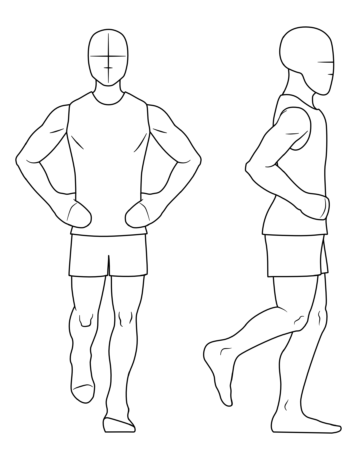
Position yourself as shown, standing on one leg with the supporting knee very slightly bent 5°-10° and inside of the arch of your foot raised up.
Slowly raise your support heel off the ground, and then slowly lower the support foot’s heel back to the ground again, and straighten your knee. Keep your pelvis as level as you can while you do this.
Repeat the exercise 10 times 4 times daily. Don’t let your pelvis tilt or turn inwards (be crooked). Try to keep the kneecap of the support leg positioned over the 2nd to 3rd toes when it’s slightly bent forward. It is important not to let your knee turn inwards while bending the knee and standing on one foot.
Now try on the opposite foot. In time try and increase repetitions to 30 gradually building up from 10.
The quadriceps are the main braking muscle during ground contact, and they help absorb impact energy. Failure in the strength of these muscles is not a good thing at all, as shock waves from impact are associated with a number of injuries such as shin splints. Long strides when running cause increased strain of the quadriceps, which is why long-running strides should be avoided. The exercise above is also excellent for strengthening quadriceps as well as hip abductors, but this extra addition will concentrate effort on the quadriceps:

Standing on one leg with the supporting knee very slightly bent at around 5° and the arch of your foot slightly raised.
Slowly increase the bend in the knee to 15° and hold for 5 seconds and then extend your knee back to 5° flexed starting position. Keep your hip as level as you can and you flex and extend your knee.
Repeat the exercise 20 times twice daily. Try and build to 40 repetitions gradually.
Repeat both exercises for the opposite leg.
Gluteus maximus is the largest muscle in humans and plays an important role in assisting the quadriceps to dissipate impact energy and help move the body forward in unity with the calf muscles. Effectively the gluteus maximus slows us down when we impact the ground, and then helps move us forward over the leg, until the calf muscles then take up the role, helping to propel the body forward in unity with the leg swinging through the air on the opposite side. Poor gluteus maximus strength, therefore, can cause overload on the quadriceps and the calf muscles, while poor calf muscle strength and quadriceps strength can overload the gluteus maximus.
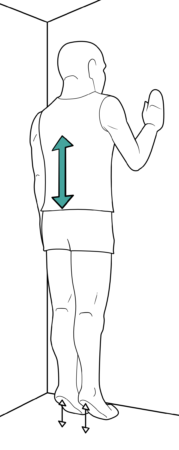
The exercises best to strengthen gluteus maximus are already given above for your hip abductors and quadriceps, but just try and grip your buttocks tightly while performing these exercises.
You can keep your calf muscles and gluteus maximus strong with these simple exercises:
Stand up straight with one hand against a wall for support, but only if that support is necessary. If you can maintain your balance, don’t use your hands. Slowly rise up on to the toes as high as is comfortably possible.
Keep the weight slightly towards the base of your big toe and grip tightly in your buttocks.
Now lower the heels down as slowly as you can until the heels are just hovering above the ground. Hold for two-three seconds and rise up again.
Repeat 20 times 3 or 4 daily. Increase as this becomes easier.
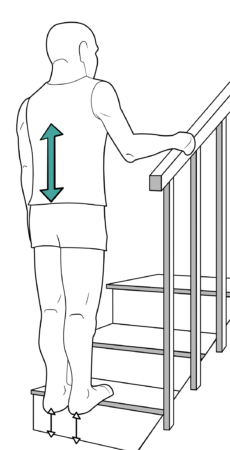
Once you find it easy try doing it on one leg, but you will probably need to support yourself on the wall.
Use the bottom step and hold onto the banister to keep yourself stable and stand nice and straight in the back keeping your posture erect and straight throughout the exercise. Now drop your heels down over the step, with your forefeet on the step. Hold for two seconds then rise up onto your forefoot nice and high, and then immediately, but very slowly let your heels drop all the way down again.
Repeat 10 times
Over time gradually increase the repetitions adding 4 or 5 at a time. If it feels easy to do this exercise, add another five each day until it starts to feel harder than slow up the additions.
It shouldn’t be long until you can 50 very easily. If so it will be worth trying the exercise on one leg at a time, but reduce back to 10 repetitions for each leg and start to build up again.
Foot Exercises
Feet are the all-important base of support for your legs to move over as you run. To achieve this role feet have to change shape and flexibility passing from a more compliant energy-absorbing structure at impact to a stiffer more ‘lever-beam’ like structure as you push off the ground. Therefore keeping feet strong and flexible is very important.
Try these simple exercises for your feet:
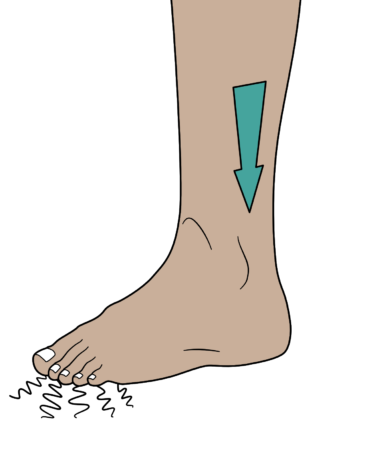
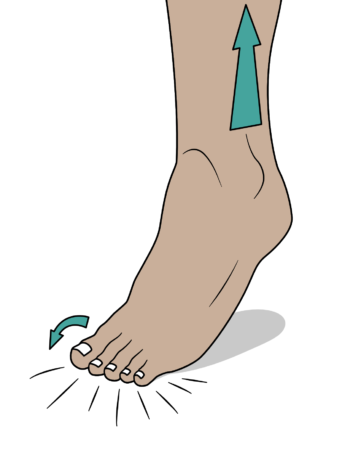
Grip your toes to the floor, not so they buckle but so they contact the floor firmly. Quickly rise up onto your toes. Then in a quick but controlled movement allow your heels to go back to the floor.
It is important that you land on your heels very lightly, hardly bearing weight on your heel. The whole movement should be controlled throughout.
The pressure should remain on your forefoot. Hold for 2 seconds. Then repeat the exercise 10 times.
As you repeat the exercises you will feel strain building in your feet behind the toes, in your calf muscles, and finally deep in your buttocks. Repeat 4 times daily. This exercise is most comfortable with shoes on.
For Further Foot Strengthening, Try These Exercises
Cycling Machines
Static cycling machines offer an excellent option to get the heart rate pumping and your breathing rate up. The negative side is cycling machines are difficult to set up like a normal racing road bike so your posture is very different as you peddle. This means you should not expect your cycling machine to allow you to perform the exercise in exactly the same way as normal cycling. It is wise to lower your expectations and reduce your cycling time to around 25% of your normal time at first. Once your body adapts to the new posture you can start to increase the duration of your exercise.
Bike trainer rollers or rolling road type equipment offer one of the best solutions, as for triathletes and cyclists you can continue to train on your bike with its usual postural settings. If you can take your bike out into the garden to use on the rolling road, even better. If there is wind in the garden, face the bike into the wind for even more realism.
Treadmill
This will seem like the ultimate solution for runners lucky enough to have access to a treadmill. Again they are an easy way to get some blood and air pumping around your body to keep your fitness up. What could be better than running on a treadmill if you’re stuck indoors or in your garden?
There are some facts about treadmill running worth knowing. Your running style is different on a treadmill compared to the road or other terrains. Runners tend to develop shorter strides and more steps per minute on a treadmill, although for most people the difference is small. However, if you have not run on treadmills before you’ll need some time to acclimatise. If you’re new to treadmills, get used to walking briskly on them before running, and don’t be tempted to see how fast you can go. Remember if you suddenly need to stop, you might but the treadmill won’t until you’ve hit the button. Be cautious on a treadmill and be safe.
Everyone here at HealthyStep® is keen to see you stay safe from Corvid-19 through following UK government guidelines, but it’s also important to keep your body safe from other injuries, both now and when you return to your normal exercise regimes.
Remember it is possible that during quarantine your physical fitness levels may drop. When it’s all over, be wise and adjust your activity.
Reduce your peak activity levels by around 40% at first, then gradually start to build up again, but no more than 10% per 4 or 5 sessions of exercise. Do this and you will reduce the risk of injury.
Good luck, stay safe and keep fit.
